How Much Does it Cost to Run a NAS 24×7?
If you are looking at buying a HIGH CAPACITY but COMPACT NAS drive in 2022/2023, then you will likely also be wondering just about much power it is going to use. The growing cost of electricity and how much you ned to factor this into your budget is quite a valid concern. Due to any one of about a hundred different global factors (local conflict, slow renewable energy uptake, monopolizing energy companies with powerful lobbying – take your pick!) most of us in 2022/2023 have seen increases in energy costs. In this energy-aware climate, it can be appreciated that a NAS drive (a 24×7 appliance) seemingly has its cost to the end user in terms of electricity as something of a vague number. With so many kinds of NAS available in the market, featuring a mix of CPUs, PSUs, Bays and utilities, PLUS the wide range of HDD/SSD drives in the market to choose from – there are just so many variables when trying to work out how much power your NAS drive is using and how much that is translating to in your monthly energy bill! So, today’s article is about working out how much electricity the new 2022/2023 generation QNAP TS-464 NAS and four (current maximum capacity in the NAS HDD world) WD Red Pro 22TB HDDs will consume, as well as how much that equals to you in £, $ or € per day, month and year! We tested the popular 2020 generation desktop 4-Bay NAS system previously HERE, so this will be a notably more power-hungry setup by comparison. In order to keep an eye on usage, I connected them to an energy monitor and worked out how much power they used in full active use and in idle. Let’s begin.
|
The QNAP TS-464 NAS
Current Price/Availability on Amazon –$689+
|
The WD Red Pro 22TB HDD (x4)
Current Price/Availability on Amazon –$699
|
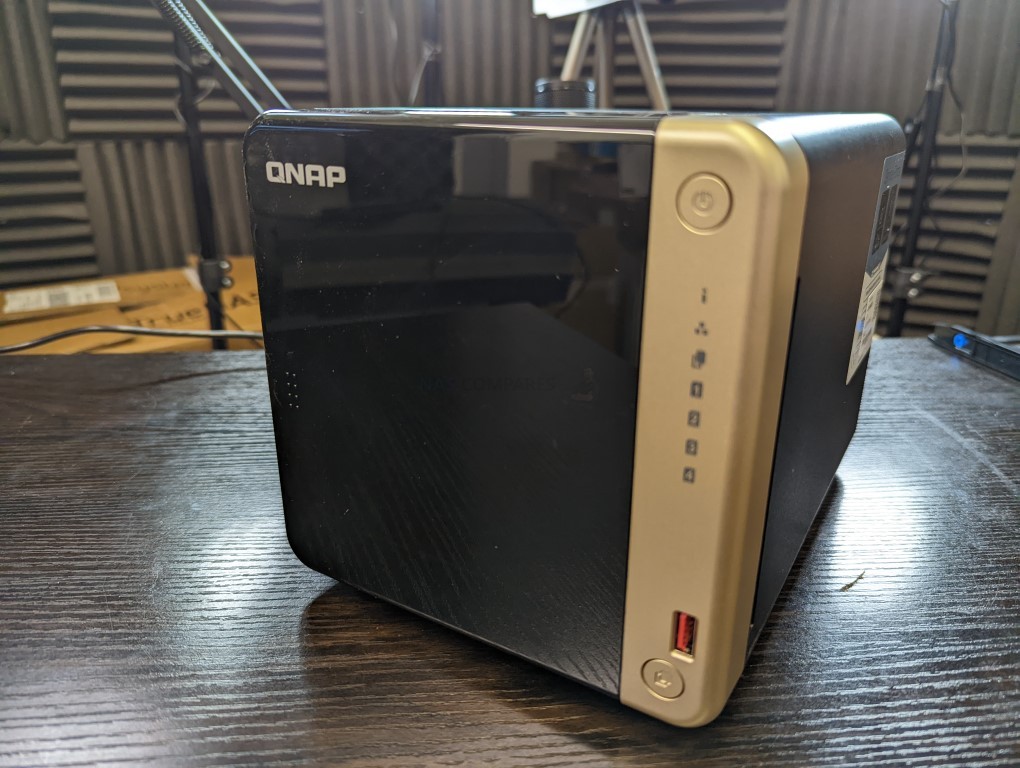 |
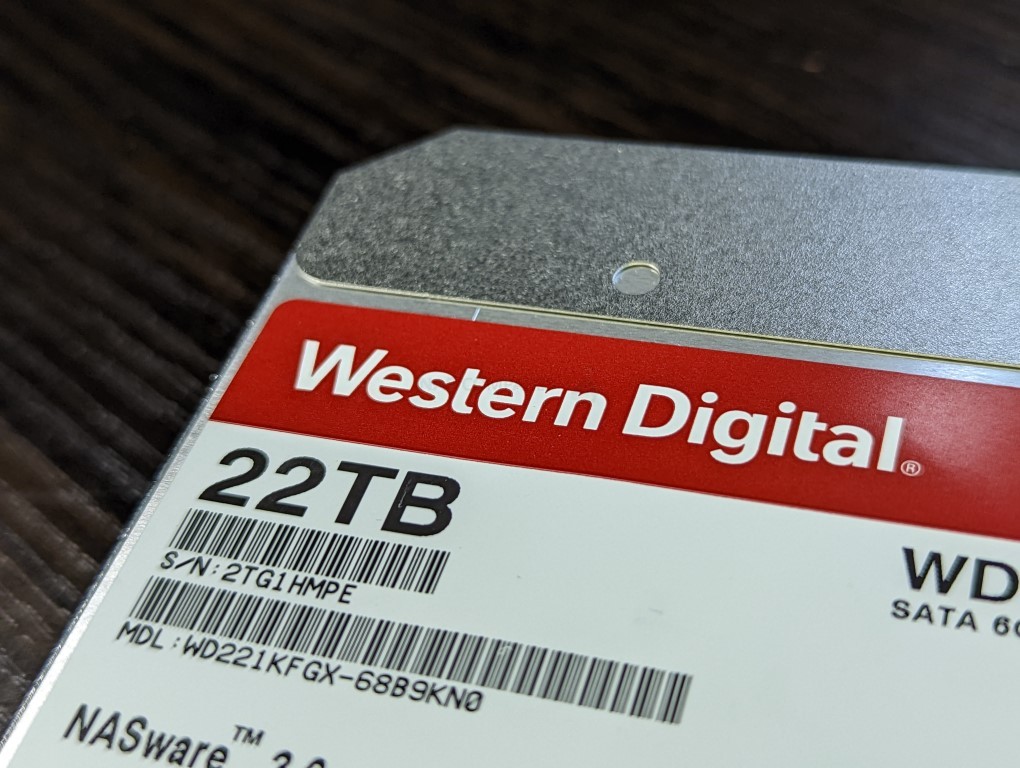 |
|
Intel N5105 CPU, 4-Core 2.0-2.9Ghz Celeron CPU
4GB 3200Mhz non-ECC Memory, 2.5GbE |
22 Terabyte Capacity – SATA 3.5″ Form Factor
7200RPM – 512MB Cache – 10x 2.2TB Platters
|
NAS Power Use Test Setup
Choosing the appropriate NAS drive for these tests was always going to be tough. I DO intend on repeating these tests with several different NAS drives after this in some follow-up articles (the larger article that I will be adding to can be found HERE), but wanted this test to be focused on one of the newest releases for home users by QNAP (and the TS-464 is their latest prosumer devices and already quite popular). This NAS has been paired with the WD Red Pro 22TB HDD, which are the biggest drives that WD has ever introduced into their WD Red Pro series of NAS media. The aim here is to identify the difference between using newer gen CPUs and Larger drives vs using older-generation devices and smaller-capacity media. This will involve 2x tests on each NAS+Media configuration. Here is a breakdown of the hardware configurations and test architectures:
- QNAP TS-464 NAS, Default Celeron+4GB Memory Setup over 1/2.5GbE
- 4x WD Red Pro WD221KFGX 22TB (QNAP Test in RAID 5
- During ‘ACTIVE’ 24hr Tests, the NAS was prevented from going into standby/idle. 1 VM running, 1-Core and 1GB Memory, 2x IP Cameras recording non-stop, drive S.M.A.R.T tests scheduled to be hourly
- During IDLE 24hr Tests, the VM was deleted, VM and Surveillance Software disabled, ALL S.M.A.R.T tests disabled and network cable (1GbE network, 2.5GbE Port) disconnected.
- The first day of operation (which includes initialization and RAID creation) not counted (but visible at the start of the graph).
- Power was monitored with a GOSUND SMART KIT Smart Plug, Mini 13A – Find HERE
The initial 24 hours (used for system initialization and RAID configuration) were NOT included in the power usage monitoring, as although they appear on the graph they are one-off single-event scenarios. Each test (Active vs Idle) was conducted for 24hrs and the overall electricity usage was displayed in kw (kilowatt). But what is the difference between Active and Idle activity? Why does it matter?
What is the Difference Between a NAS Drive ‘Active’ and in ‘IDLE / Standby’?
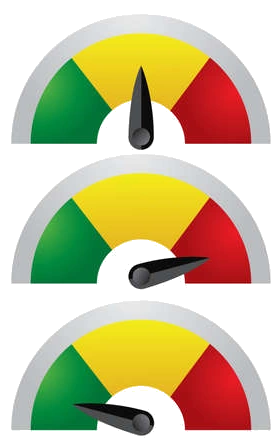
Although a NAS is designed to be in operation 24×7 and is consuming electricity when running, the actual reality of this and the extent to which it is consuming it is actually alot more nuanced. Most home users who have a NAS system will use the NAS directly for a significant;y smaller portion of time per day than it is actually powered on for. Perhaps to stream a movie or a couple of TV episodes, run a daily backup, have a couple of cameras in/outside their home that are sending recordings (or more likely just alerts and associated captures) to the NAS and that is about it. They will periodically do more than these, maybe a VM, more sophisticated backup or use some of the other services ad hoc, but the result is that in most domestic/bog standard home scenarios, a NAS will be switched internally to Idle/Standby after no pro-active use quite quickly and spend 80-90% of the time in low power modes. Business users might well be using the system 24×7 for sync’d tasks and on-going camera recording, but even then, this will be a lower % of system resources in use. So, in order to find a comparable and relative means to study the electricity use of a NAS and it’s cost, I have conducted two tests per NAS+HDD configuration. The first, a 24 Hour Active test, with the system using a decent % of it’s CPU+Memory, a swell as the HDDs not being given the chance to switch to Idle/Standy (by constantly writing AND performing S.M.A.R.T tests hourly). The idle tests involve all of those apps, services and scheduled operations being cancelled and the network cable being disconnected from the NAS (for another 24hrs). From here we can work out the cost of an hour of power usage by either setup in high activity and near-zero activity. But how can we work out the COST of the electricity used by the NAS in that time period?
How Energy Costs in these NAS Tests were Calculated?
The results of the energy usage are then cross-referenced by ‘sust-it.net’ and calculations of the cost of the used electricity per day, month and year was calculated for the UK, U.S, Germany, Australia and Canada. Now, using a select energy tariff is much harder, as there are quite literally thousands of different energy providers globally, each with their own pricing on the cost of energy per ‘kWh’. So, I used the national average calculations that were provided by ‘sust-it’ for each of those areas. Some are clearly more up-to-date than others (i.e the United Kingdom Avg Energy cost tariff is dated October 2022, whereas the Canada’s average energy cost is from way back in March 2020), however, these will still provide a good basis for understanding what a NAS drive is going to cost you in electricity when it is in operation. The national tariff averages used in this article for each region are as follows:
UK: Energy Price (October 2022) electricity rate of 34.00 pence per kWh.
USA: Average (Feb 2022) electricity rate of 14.80 cents per kWh.
Germany: Average (June 2021) electricity rate of 31.93 Eurocents per kWh.
Australia: Average (March 2022) electricity rate of 23.59 cents per kWh.
Canada: Average (2020) electricity rate of 8.50 cents per kWh.
Source – https://www.sust-it.net
There are the rates that we will be using to calculate the running costs of the QNAP NAS system (and more importantly its WD Drive setup and CPU usage).
Test #1 – QNAP TS-464 NAS and 4X 22TB WD Red Drives
I set the QNAP TS-464 NAS and WD Red 22TB Hard drives up in the following configuration for the Active tests:
- QNAP TS-464 NAS PSU = 100W External PSU, Intel Celeron N5105 Quad Core 2.0-2.9Ghz, 4GB DDR4 3200Mhz Memory
- WD Red Pro 22TB HDD, RAID 5
- QVR Pro 9 and 2x Reolink Dome IP Cameras (24hrs Active)
- QNAP Virtualization Station, 1x Windows VM, 1 Core, 1GB Memory (24hrs Active)
- QNAP Storage Manager (QTS 5.1) and S.M.A.R.T Tests per Hour (24hr Active)
- Reported Average power requirements of a WD Red Pro 22TB (Single):
- Read/Write: 6.8
- Idle: 3.4
- Standby Sleep: 1.2
The initialization and RAID creation on the QNAP + WD Red Pro 22TB RAID setup took longer than the previous test and also resulted in a higher power consumption (with RAID ReSync set to High Priority) ending in 0.73kW (versus the 0.42 during the more modest Synology/WD Red Plus setup). Indeed, this continued into the 24hr active period, with this setup ending at 1.28kW use during high active use and 0.59kW during the 24hrs idle period.
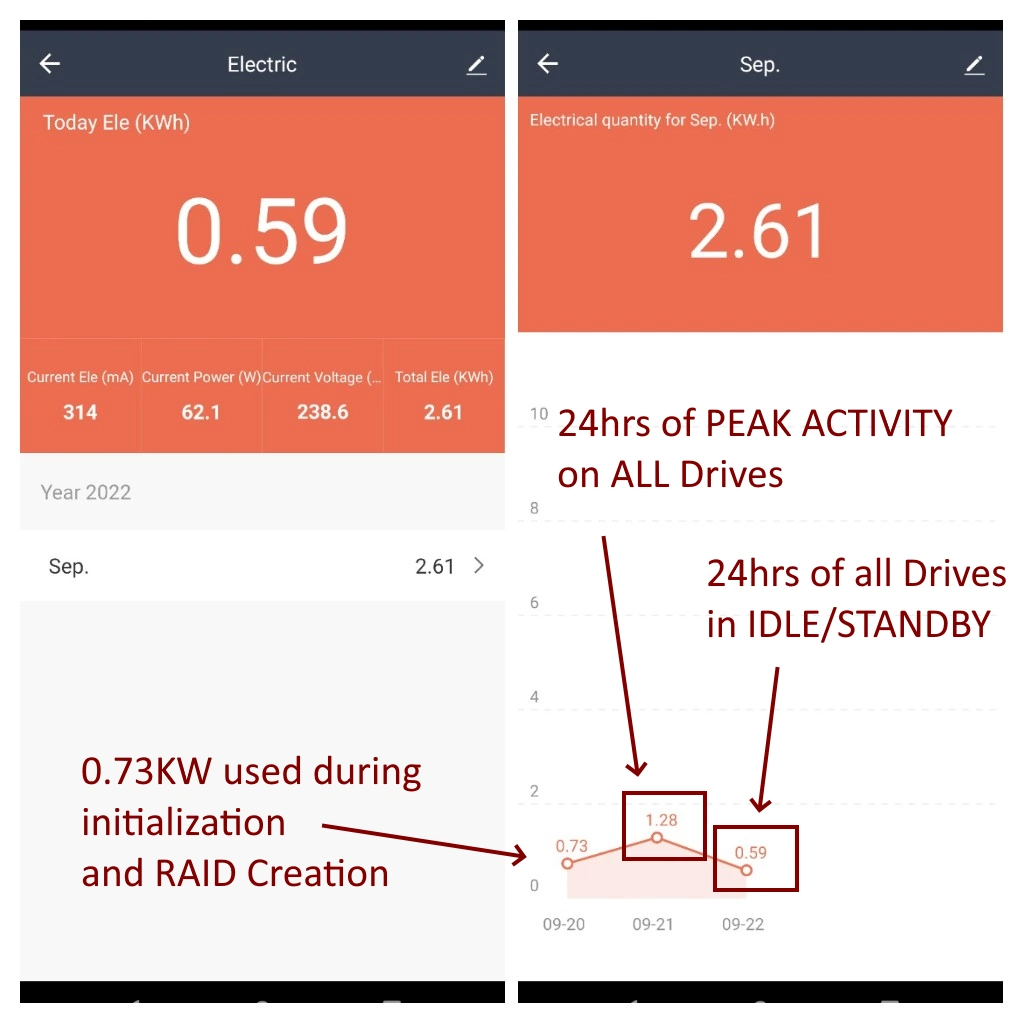
The difference that a more powerful/capable CPU and the more than 5x Capacity of those WD Red Pro drives did to the power consumption is pretty clear and certain. Let’s see how those results translated into your potential energy bills.
QNAP TS-464 NAS and WD Red Pro 22TB HDD Test Results:
1.28KW divided by 24 (hours) = 0.0533kW use per Hour
| 24hr Active Use (1.28KW) | UK Power Use | U.S Power Use | Germany Power Use | Australia | Canada |
| Cost Per Day | £0.4349 | $0.1893 | €0.4084 | AU$0.3018 | CA$0.1087 |
| Cost per Month | £13.22 | $5.75 | €12.42 | AU$9.17 | CA$3.30 |
| Cost Per Year | £158.73 | $69.09 | €149.06 | AU$110.15 | CA$39.67 |
0.59KW divided by 24 (hours) = 0.0245kW use per Hour
| 24hr Idle Use (0.59KW) | UK Power Use | U.S Power Use | Germany Power Use | Australia | Canada |
| Cost Per Day | £0.1999 | $0.087 | €0.1877 | AU$0.1387 | CA$0.05 |
| Cost per Month | £6.08 | $2.64 | €5.70 | AU$4.21 | CA$1.52 |
| Cost Per Year | £72.96 | $31.75 | €68.51 | AU$50.62 | CA$18.25 |
So, what about if you were to only use the NAS at active use for around 25% of the day (i.e 6hrs of active with backups, multimedia, etc) and 75% of the day as idle (i.e 18hrs unused):
25%/75% Active/Idle Use:
| 6hr Active Use / 18hr Idle | UK Power Use | U.S Power Use | Germany Power Use | Australia | Canada |
| Cost Per Day | £0.2586 | $0.1125 | €0.2428 | AU$0.1794 | CA$0.0646 |
| Cost per Month | £7.8665 | $3.4233 | €7.387 | AU$5.457 | CA$1.964 |
| Cost Per Year | £94.39 | $41.08 | €88.64 | AU$65.49 | CA$23.57 |
With the 25 % Active and 75% Idle ratio, the pricing on this high-capacity solution does seem alot more palatable. Still, there is no denying that in order to enjoy more modern large-capacity media, there can be a hidden cost as this technology becomes more industrious. Stay tuned, check below to see if other NAS power tests have been published and recommended to you, or watch the video version of these tests (which goes into more detail on the current predicaments in the energy crisis facing many of us in 2022, 2023 and beyond.
📧 SUBSCRIBE TO OUR NEWSLETTER 🔔
🔒 Join Inner Circle
Get an alert every time something gets added to this specific article!
This description contains links to Amazon. These links will take you to some of the products mentioned in today's content. As an Amazon Associate, I earn from qualifying purchases. Visit the NASCompares Deal Finder to find the best place to buy this device in your region, based on Service, Support and Reputation - Just Search for your NAS Drive in the Box Below
Need Advice on Data Storage from an Expert?
Finally, for free advice about your setup, just leave a message in the comments below here at NASCompares.com and we will get back to you. Need Help?
Where possible (and where appropriate) please provide as much information about your requirements, as then I can arrange the best answer and solution to your needs. Do not worry about your e-mail address being required, it will NOT be used in a mailing list and will NOT be used in any way other than to respond to your enquiry.
Need Help?
Where possible (and where appropriate) please provide as much information about your requirements, as then I can arrange the best answer and solution to your needs. Do not worry about your e-mail address being required, it will NOT be used in a mailing list and will NOT be used in any way other than to respond to your enquiry.

|
 |
Gl.iNet Slate 7 PRO Travel Router (and Beryl 7) REVEALED
Minisforum N5 MAX NAS - 16C/32T, 128GB 8000MT RAM, 5xSATA, 5x M.2, 2x10GbE and MORE
The BEST NAS of 2026.... ALREADY??? (UnifyDrive UP6)
How Much RAM Do You Need in Your NAS?
A Buyer's Guide to Travel Routers - GET IT RIGHT, FIRST TIME
Jonsbo N6 DIY NAS Case Review
Access content via Patreon or KO-FI
Discover more from NAS Compares
Subscribe to get the latest posts sent to your email.


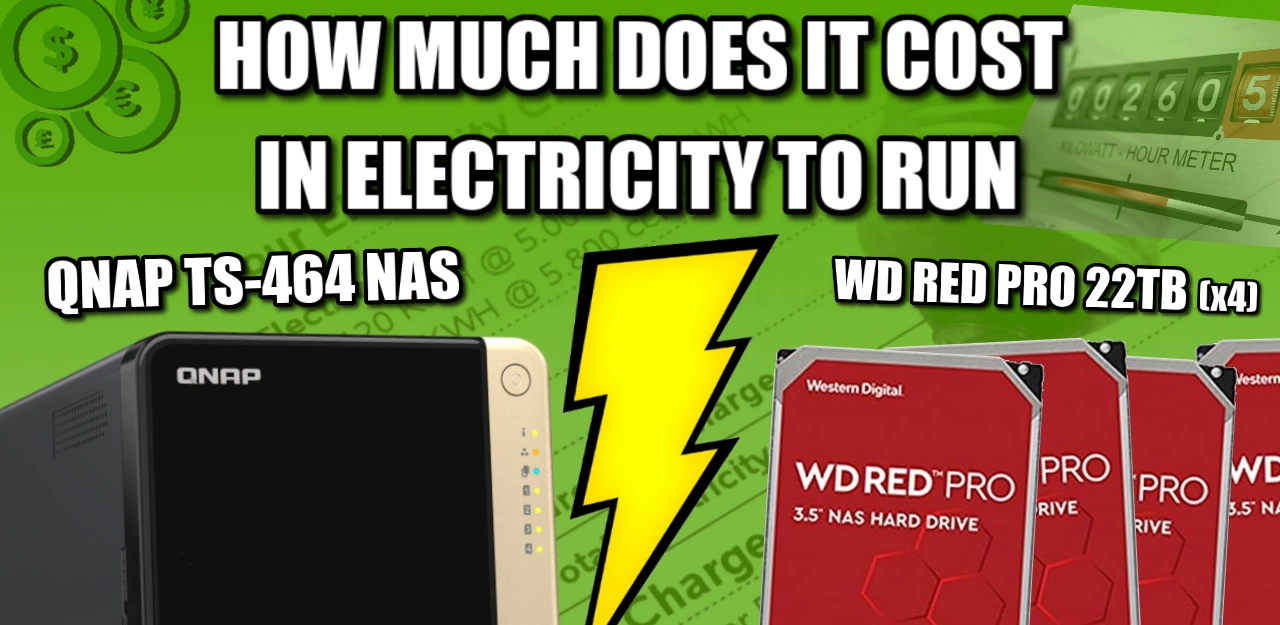



Conclusion of this video: I move to Canada, Germany is way too expensive ????
REPLY ON YOUTUBE
About 80% of the electricity produced in Canada is from green sources, most of it being hydroelectricity. Fossil fuel price fluctuations do not affect Canada very much. Most people I know refer to electricity as “hydro” because hydroelectricity is virtually the only source of electricity for us here in British Columbia.
REPLY ON YOUTUBE
It’d be great to see this test done on a TVS-872X with those 22TB Pro drives
REPLY ON YOUTUBE
I really appreciate these tests. When I’m working the energy consumption is less a concern because I’m getting value out of the system. However the idle consumption is of great importance for a 24/7 system.
So if my calculations are correct your tests show .59kwh *1000/24 = 24.6 watts idle power….that is not particularly good since I would hope for something more like <=10watts...maybe the Wrd reds are the way to go(maybe have to go back and look at that video)
REPLY ON YOUTUBE
Please test qnap ts251d, mine never stops spinning don’t know why, i end up turning it off because i worry about the cost especially now with things going crazy, also i get a bit of peace. I have a 2 bay with 2x 4tb ironwolf nas drives. Good show very interesting????????????????????
REPLY ON YOUTUBE
If you are using a UPS, the energy used is tracked and even generates reports on utilization and costs (all APC units have the software). Just plug in your current rates and reports can be automatically generated. These reports will generate hourly, daily, monthly, and yearly data.
REPLY ON YOUTUBE
I was looking forward to this video. I almost have the same setup.
REPLY ON YOUTUBE
That power meter your using, is it a proper power meter? The reason I ask, the cheap smart home plugs on show the average usage, not the actual…. It’s not showing the real value…if just a smart home plug.
REPLY ON YOUTUBE
I’d wrongly expect a pro drive to use less power. The reason for my though… if it’s pro it should be better, not worse. All those pro drives in service, would be wasting so much power in bulk…an a business would look to reduce costs….I’m wrong ????
REPLY ON YOUTUBE
12.8c/day CAD going off your numbers with the variable rates I get in northern Canada.
REPLY ON YOUTUBE
Would be interested to know about a QNAP TS-431X3 with 2 x WD80EFBX drives and 2 x WDS100T1R0A SSDs cheers! I have mine on 24×7 and thinking about doing some kind of scheduled power down (maybe when not in use?) and then i power on when i need them – to try and save power.
REPLY ON YOUTUBE
Hello. What 8-16TB hard drive would you recommend for a home server? I want it to be as quiet as possible.
REPLY ON YOUTUBE
I was already wondering, what it would “cost” me, running my TS253D with 2x8TB tochiba G08 disks .. thanks for the insights!
REPLY ON YOUTUBE